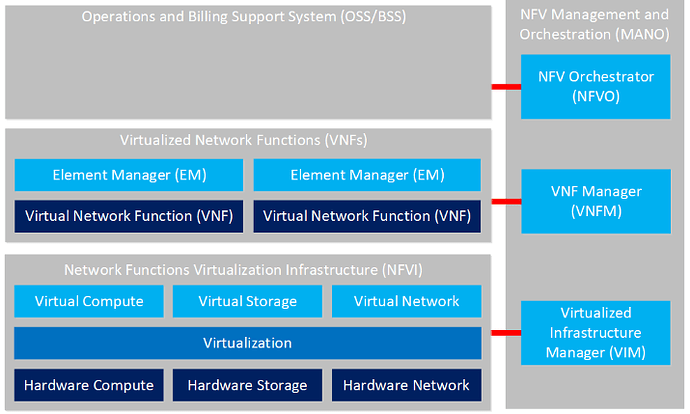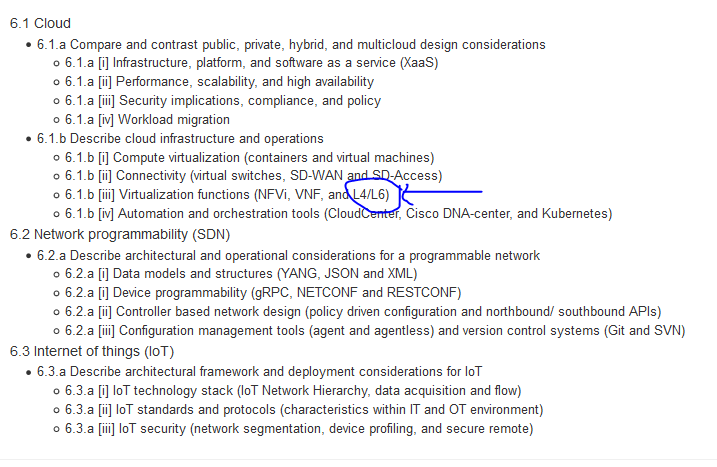This topic is to discuss the following lesson:
what is the use of nexus switches in NFVI ? is it to connect to external network or NFV fucntion can virtualize nexus switch function ? does it replace existing router switches or does it use existing hardware routers and switches for Network virtualization. - confusing on NFV concept.
Appreciate if anyone can give some light on it.
Thanks
Hello Umesh
The NFVI as a framework has several components. These components can be separated into two categories: hardware and virtual. Among the hardware components are the Nexus series devices. Nexus devices essentially provide the physical connection to the virtualized NFVI environment. Looking at the diagram below, the nexus switches would fall under the “Hardware Network” component at the bottom right.
This might sound philosophical, but I believe it will clarify some things. We live in a physical world, and the interfaces we require are physical So even if you virtualize a large part of servers and networks, you still need some interface to the physical world to connect those portions of the network that are indeed physical. That’s where the nexus switches come in. They are the physical interface to the NFVI environment.
Only nexus devices support the Cisco NFV infrastructure and that’s why the are mentioned here. You can find out more about it at the following Cisco link:
I hope this has been helpful!
Laz
Hello Laz,
Thanks for clarification.
Hi Rene,
I’d like to know what Cisco are meaning by “L4/L6” in the official Cisco blueprint of CCIEs Evolving Technologies v1.1 exam topic specially the topic that this lesson is what about which is “6.1.b [iii] Virtualization functions (NFVi, VNF, and L4/L6)” ?
Best Regards,
Any one have info about what Cisco mean by L4/L6 ??
Hello Hussein
I have been unable to find any info about this specific statement, and the strange thing is that I cannot find anyone stating anything about it in the Cisco forums either. However, my feeling is that it has to do with VM orchestration, dealing with Layer 4 to Layer 7 services, similar to what is contained in the following Cisco documentation.
Now why it’s stating L4/L6 rather than L7 I’m not sure. I’ll leave this one for @ReneMolenaar to respond to more reliably.
Sorry I couldn’t be more helpful!
Laz
Hi Hussein,
I also did some research, trying to find a connection with either NFVI, VNF, or cloud. To be honest, I have no idea. NFVI/VNFs are about L2-L7, same with cloud. I can’t think of anything. I’d say that virtualization starts at L3 (routers) and NFVI/VNF goes up to L7.
Nothing I can think of that sits in between L4-L6.
Rene
Thank you both @ReneMolenaar & @lagapidis
I think Cisco not mean OSI layers model in this sentence instead they are meaning virtualization layers, also when I make a little search about that I found something interesting and it’s very related to virtualization function which is what this post about, in short virtualization layer mean at which level we can mange physical hardware resources for example host (Hypervisor) level, guest OS level, or program level (High-level language virtual machines), and so on, I revert this info from this wiki :-
http://en.dwhwiki.info/concepts/virtualization-layer
Also I’m junior in virtualization field and does not have much info about virtualization environment, thus I did not know why Cisco focus on L4/L6, but I find this article and see that L4/L6 are almost talking about storage and network :-
Finally I’d like to share this draft from ieft and I think it’s have some info that could be very useful in this subject, but again it’s hard for me to understand it because as I said before I’m junior in virtualization field :-
https://tools.ietf.org/id/draft-shytyi-opsawg-vysm-06.html
Hussein
Hi Rene ,
Can u please elaborate about SRIOV, OVS,BONDING , CEPH etc too.
Hello Ajay
Here is a summary of the terms that you posted.
SR-IOV - Single route input/output virtualization - This is a specification that allows the isolation of PCI Express resources for manageability and performance reasons. It enables the sharing of a single physical PCI express bus to be shared in a virtual environment.
OVS - Open vSwitch - This is an open-source software implementation of a distributed virtual multilayer switch. OVS can operate both as a software-based network switch running within a virtual machine hypervisor, and as the control stack for dedicated switching hardware.
Ceph - This is an open-source software-defined storage platform that implements what is known as object storage on a distributed computer cluster. Ceph replicates data and makes it fault-tolerant.
When you talk about BONDING I’m not sure in what context you mean. Can you clarify?
I hope this has been helpful!
Laz
Bonding – in open stack there are multiple types of bond required e.g. tenant/vxlan bond for this VXLAN is required. want to know more about open stack technologies
LAZ - please provide the complete details of SRIOV, what are the advantage, disadvantages, how it will do the isolation of PCI express resources.
Thank you,
Ajay
Hello Ajay
In order to get into more detail about all of these topics, it would be beneficial to have a whole lesson or a series of lessons dedicated to them. I suggest you go to the Member Ideas page below and make your suggestions. You may find that others have made similar requests, and you can add your voice to theirs:
I hope this has been helpful!
Laz
bonjour RENE , merci pour le cours mais je n’ai rien compris de l’utilité de ce model dans quel contexte on utilise les VNF , stp un et un résumé m’arrangerais avec des exemple simple .merci d’avance
Hello Charles
In the same way that servers and workstations can be virtualized by creating virtual machines using frameworks such as VMware, VirtualBox, and others, VNFs refer to the virtualization of network functions. A network function could be routing, so a VNF performing routing can be created within a virtualization framework to route traffic. Another network function could be the application of access lists, and that too can be virtualized.
By creating virtual network functions, it is possible to design a solution within software that delivers the specific network functions you need.
I hope this has been helpful!
Laz

